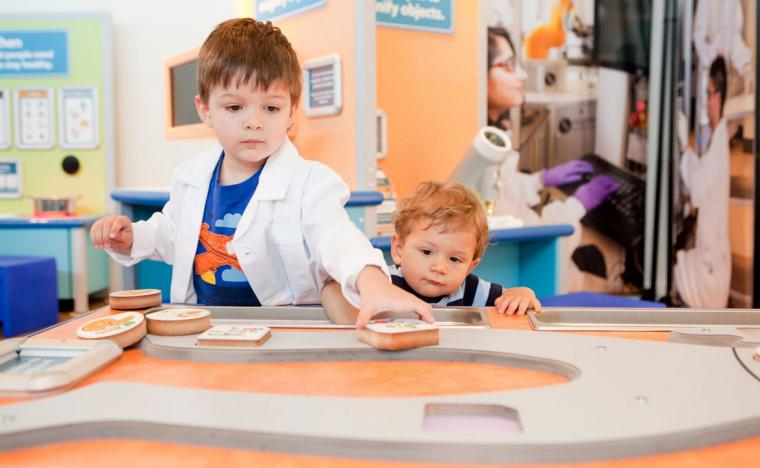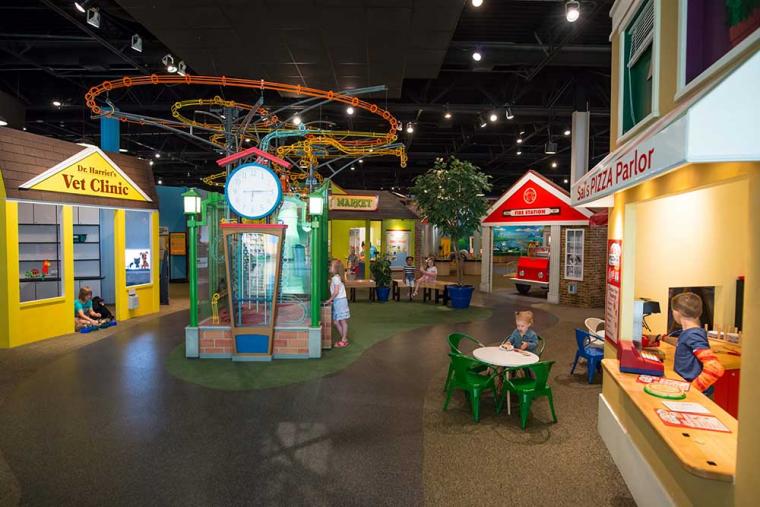
Kim Kidwell, director of the Family Museum in Bettendorf, discusses the venue's re-opening and safety measures during this period of social distancing. We spoke on Wednesday, May 27.
Preparing for the May 22 Re-opening
We normally have a pretty strict cleaning policy anyhow. But over the time we were closed, we were able to basically deep-clean everything. We took everything out, we did some of our floors, we cleaned everything from ceiling tiles to radiator grids … . Every square inch of the place. After that, we worked on projects that needed repair – some things that we were able to quick-fix while they were out on the exhibit floor to keep them going, and things we were able to fix for long-term wear.
Also, to prepare for what we were going to do when we re-opened, I participated – and a lot of our staff members did, as well – in a lot of Zoom meetings and webinars with other children's museums. We looked at all kinds of message boards and things like that with ideas and stretegies, and we also walked through the museum and took a look at all the things we had out and things we knew we should take off the floor.
We took off things that we thought were a little harder to keep clean – things that are really porous. For example, in our barn, we have lots of stuffed animals. And we have really large stuffed animals, like the horses and the donkeys and the cows. Those we normally steam-clean weekly. However, with the coronavirus happening, we really can't clean them as often as we would like. So we just took them off the floor. The smaller stuffed animals, like in our vet clinic and in the barn, we're able to throw in our washing machine several times a day. So those we kept out.
We have telephones in all of our little shops where kids can call each other. We decided to take those out, because of the close proximity to the mouth – kids sometimes lick the receivers and that kind of thing. (Laughs.) So we completely removed them from the galleries. We also had just an abundance of props out, so we tried to scale those down a little bit. That way we could readily clean them during the day while we had visitors here. Basically our plan of attack was: “Follow the CDC guidelines and be as clean as we can.”
We had cleaning drills with staff where we would set a timer and see how fast we could clean certain areas, how fast we could change out the props. And we made sure that all of our staff knows how to use all the cleaning supplies, where they're located, what cleaning supplies are used on what, what gets washed where … . We have sort of a big grid on what gets put in the washing machine, and we also have an industrial dishwasher that we wash all of our plastic props in, like our fruit and vegetables from the store, our ice-cream cones from the ice-cream cart … . Those kinds of things.
So we made sure that all of our staff, everybody, knew how to do all that, and we're all trained on deep-cleaning the restrooms, wiping off the door handles, the faucets … . Anything you could touch. Our game plan was to have people on the floor cleaning constantly, whether it's educators, whether it's our guest-services staff, whether it's people upstairs in the office. I made a schedule, and we all take turns, and we all clean.
You know, we obviously want people to come back. (Laughs.) We're happy to have families return, but we want it to be as safe as we possibly can, you know? And we realize that you can't control what a two-year-old does, and you can't force them to social-distance, you can't control everything that they put in their mouths. But that being said, we are cleaning railings, our outside play equipment, the handicapped-door pusher that all the kids love to push … . I tell you, this place is the cleanest it's ever been! (Laughs)
We have a great staff here, a great team, and everybody has been helping. So as soon as the governor gave the green light to museums and said Friday was the day, Friday was the day. We were ready to go. We did all the prep work and made all the schedules, and it was just a matter of putting it into place.
Current Museum Practices
We're limiting our guests to 75 at a time. And 75 people at a time is not a lot of people for us. We have a lot of space – we have outdoor space, we have our Great Hall space, we have our Imagination Studio on our second level. And with that, we're able to spread people out. But I came in all weekend just to see how things would go, and I noticed that families were kind of doing that themselves, you know? If there's another family in the vet clinic, they're not going to go in there – they'll go somewhere else. So they're kind of self-policing the distancing in a way, which was nice to see.
The families who came over the weekend were really thankful – and thankful to be out of the house. (Laughs.) You know, for many of them, their children haven't been anywhere. Their parents may have been to the grocery store, or to work if they were able to still go, but a lot of the kids have just been home. And so it's just your house and your yard, and other than maybe going for a walk in your neighborhood, obviously your activities have been pretty limited.
So we had many families just thankful that we were open – appreciative and happy that they could just get out, even if it was just for a few hours. Just to have a change of location. I even heard families talk about how having some sense of normalcy again was helpful. “Oh my gosh, we can get in the car and go to the museum!” (Laughs.) Especially for our members, some of whom visited here daily. I think it gave them a nice sense of normalcy just being able to get out and about.

Summer Programming
Our summer camps are still going on. Registration is this Saturday – or Friday at midnight, if you're inclined to stay up late. (Laughs.) We have online registration, and what we did is we limited all of our camps to 10 kids, and our camps for three-year-olds only have eight. Normally, we have maye 12, 15 kids in a camp, but we wanted to keep with the small-group-gathering guidelines, so we've brought that down to eight and 10.
Our camps start on June 8, and they run through August 7. They're weekly camps, and we have all kinds of different camps from age three up to seven or eight. We have dance camps, we have cooking camps, we have science – all kinds of fun stuff. It's all on our Web site. You can just click on “summer camps” and check them all out.
We are changing things up just a little bit with the curriculum of the camps. Activities may involve less working together on one project and maybe more individual projects – but in the same room, obviously. And we have taken out all of our carpets in our classrooms, because sometimes when kids sit on carpets they roll on top of each other and stuff. So we're doing more spatial seating, more flexible seating, so that we can space the kids apart, and as far as sitting at tables and doing activities, we're going to do our best to keep the kids at least a couple chairs away from each other.
Is it gonna be perfect? No. But we can do the best that we can do. We're santizing everything,we're rotating toys in and out, we have individual supplies for the kids to use – like their own scissors and glue for the week. We have hand sanitizer, lots of hand washing, and we're gonna try to give the kids an experience here at the museum rather than something online – something virtual that a lot of the elementary-aged kids have obviously been doing since March.
Kids need socialization. That's part of who they are and how they learn. So we're gonna do the best we can and offer a good experience. And if parents don't feel comfortable signing their child up, that's awesome. If they're not ready, I completely understand. You know, everybody's sort of at a different place, and that's okay. But we figured we would offer it, and if people are ready for that, then we're ready to have them here.
And we are having our summer traveling exhibit, which is Curious George. We were planning on having Thomas the Tank Engine. That exhibit, however, is stuck in New York City, and as you know, they're under more strict guidelines than we are. So since they're unable to go to their museum and pack it up and send it to us, we have Curious George in its place, and that will actually be opening up to the public on Saturday, June 6.
Heading into the Future
Every institution is different, and every institution might have their own sets of guidelines for different audiences. Obviously, for us, we have a lot of kids age eight and under – a lot of young families who come. So for other institutions, my advice would be to just to try to get the best, safest possible experience for people, and let them know, “We do care about the health and well-being of the community. We're not opening to be insensitive and have crowds and crowds of people here.”
So getting everybody on-board is important, having a positive attitude … . And also, you have to be kind of open to change, you know? I mean, we were willing to change out our props out every half hour. We had this down. And then the reality of the situation was like, “Oh my gosh, we can't do that – we're gonna be exhausted!” (Laughs.)
So, you know, aim high, but don't get frustrated if your plans don't come out exactly the way you thought. You have to be willing to ebb and flow. So we keep open minds around here, and if someone sees something that they think needs to be changed, or they have an idea they want to try, we're willing to try it. We really just want people to have a fun experience and a safe experience, and feel like they can trust the museum and the city, and that they can bring their families here.
It's so hard, I think, when people have been home for so long. It's very daunting, maybe, to start going places again. I completely understand that. So let's start off slow, and as the weeks move on, hopefully everyone will become a bit more comfortable.
Follow venue updates and activities at FamilyMuseum.org and Facebook.com/FamilyMuseum.








